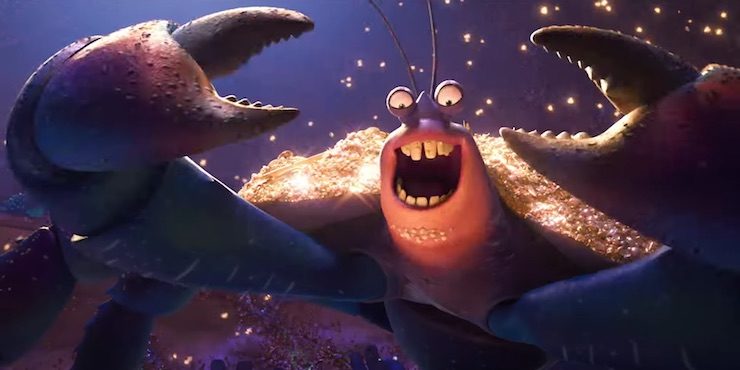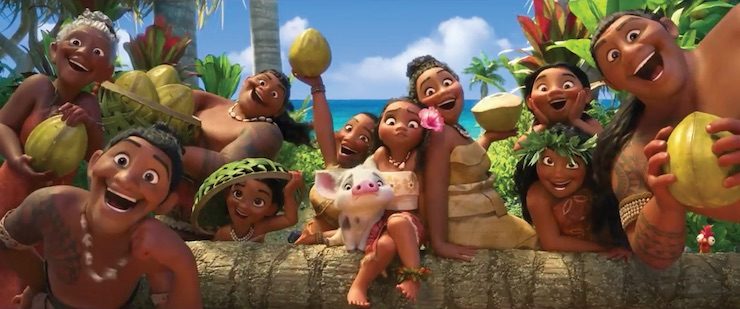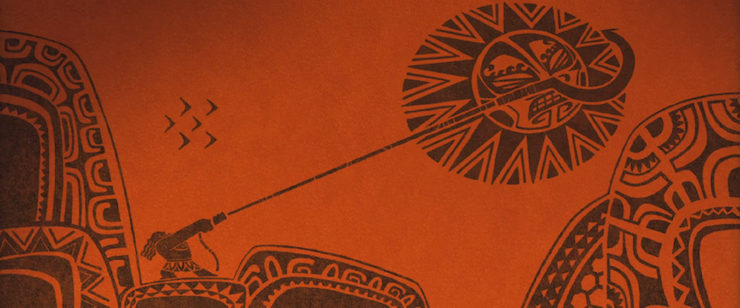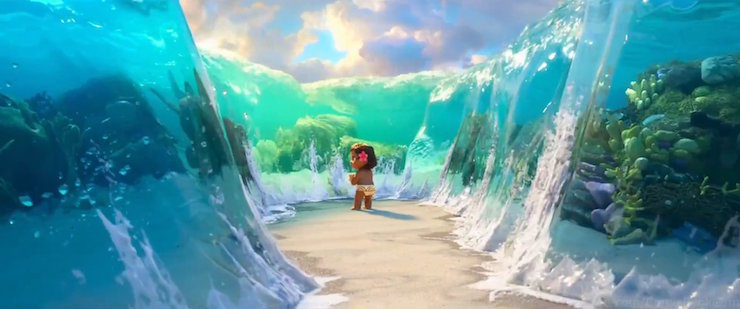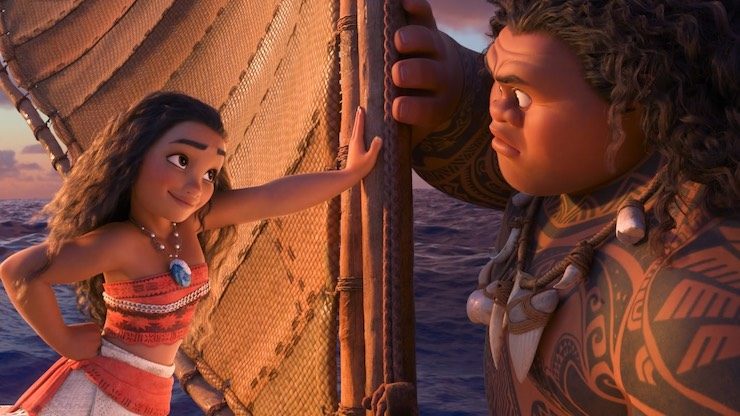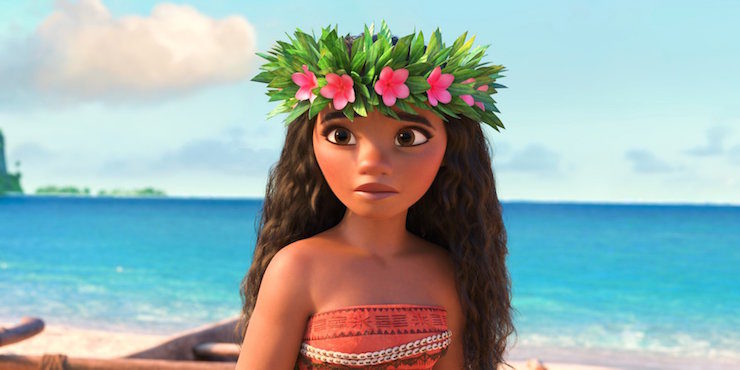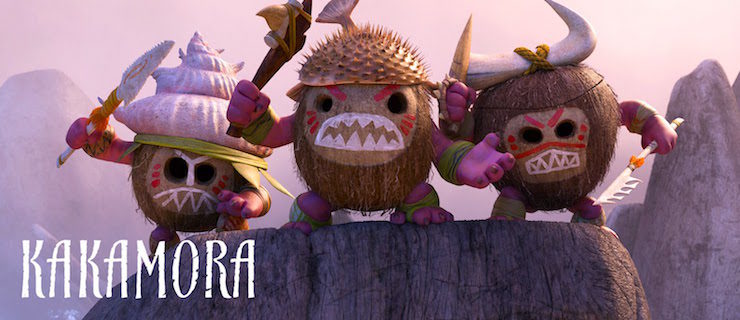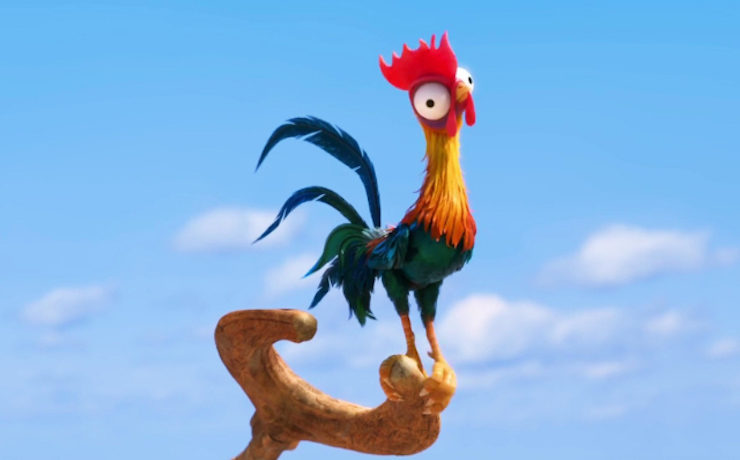“If you wear a dress and have an animal sidekick, you’re a princess.”
“Sometimes the world seems against you/the journey may leave a scar/but scars can heal and reveal just/who you are….”
Exact numbers are hard to come by, but certainly, since its introduction in the early 2000s, the Disney Princess franchise has been one of Disney’s most valuable properties, currently behind only Star Wars, the Marvel Universe and Winnie-the-Pooh in terms of revenue and popularity. The line includes not just films and videos featuring adorable princesses, but also related merchandise ranging from toys to clothing to books to furniture and wall paint, not to mention various theme park and Disney Cruise Line attractions. It was therefore nearly inevitable that just a few years after Frozen—a film so successful that it ended up spawning its own franchise and never becoming a Disney Princess film at all—Disney would find itself back into Princess territory again. This time, out in the Pacific Ocean.
Spoilers ahead.
A couple of disclosures before we get going. First, since I can’t see 3D effects, I saw this film in 2D. I can say that—apart from a few scenes here and there clearly designed to take advantage of the 3D process—the film works just fine in 2D, but it’s possible I missed some nuances or animation effects here and there. Second, I watched Moana in an audience filled with small, very excited and very noisy viewers, half left in tears just from the Cars 3 trailer (really, Pixar?) and half upset because they wanted to see Trolls or Fantastic Beasts and Where to Find Them instead. Which is to say, things did not start out well, and that “not well” meant that I missed some early moments and dialogue.
By the end, every small viewer was completely enthralled and wanted to see the film again.
I should also disclose right now that apart from one long ago trip to Hawai’i and a vague memory of hearing that taking lava rocks from Hawai’i brings bad luck, my knowledge of Polynesian culture can be summed up with the phrase “none whatsoever,” and I am considerably more familiar with Atlantic marine biology/species than Pacific species—though I’m not entirely sure the animators were attempting to make any such distinction. (The dolphins, for instance, are pretty generic looking dolphins not apparently intended to be identified with any specific dolphin species.) So if you are looking for a post able to dive into either one of those issues, this is not that post.
To head their new film, Disney selected the two men arguably most responsible for spearheading a revived interest in Disney Princesses: John Musker and Ron Clements, who had been responsible for three of the eleven previous Disney Princess films: The Little Mermaid (1989), Aladdin (1992) and The Princess and the Frog (2009). They had also directed Disney’s greatest ever flop, Treasure Planet (2009) but in the past few months, Disney’s publicists have kindly overlooked this little detail, so we should as well. They also happened to find themselves completely free, since their attempt to adapt a Terry Pratchett novel had run into the tiny issue of not actually getting the film rights for said novel, so they had the time to focus on another Disney Princess film attached to the sea.
Chief Creative Officer John Lasseter liked the general idea of a Pacific Islands inspired film, but urged both Musker and Clements to do more research into Pacific cultures in order to shape the story. This meant, as the two admitted with just a hint of embarrassment in later interviews, several journeys to various South Pacific islands, accompanied by Disney photographers shaping the now inevitable The Making of Moana featurette for the forthcoming Blu-Ray. (Some of these clips, released as part of the promotional tour, are available on YouTube and on ABC and NBC websites.)
Musker and Clements later said that the trip changed the story “tremendously,” inspiring them to stay closer to Polynesian culture than they had with most of their other films. Along with including elements inspired by their South Pacific tour, they hired a part-Polynesian story artist, David Derrick, who put a rubbing of his ancestors’ gravesites over his desk for inspiration, and hired native choreographers to help animators create some of the film’s dance sequences. Hawai’ian screenwriters Aaron and Jordan Kandell were brought in to help out with what was now becoming an almost inevitable discovery of major story problems just as the film was rushing to completion.
In further deference to the film’s Polynesian roots, Disney largely hired voice actors with Polynesian roots, including part Somoan Dwayne Johnson/The Rock; part Maori/New Zealander Rachel House; part Maori/New Zealander Temuera Morrison (probably best known to most of you as Jango Fett from Star Wars); part Maori/New Zealander Jemaine Clement; part Hawai’ian singer Nicole Scherzinger (oddly, given her background, for a role that included only limited singing) and, after a long worldwide search, debut actress and Native Hawai’ian Auli’i Cravalho, at 14 among the younger voice actors for Disney protagonists.
Sidenote: Also available on YouTube: a few completely adorable vids of Auli’i Cravalho recording her dialogue and Dwayne Johnson going around taking selfies, as you do.
Disney filled out their mostly Polynesian cast with three non-Polynesian voices in small roles: Christopher Jackson, who originated the role of George Washington in Hamilton, brought over in part by Lin-Manuel Miranda to perform some of the musical bits; Lin-Manuel Miranda himself, who jumps into one of the songs, and Alan Tudyk, by now a near Disney tradition, for the voices of Hei Hei the rooster and a villager.
To add a touch of authenticity to the soundtrack, Disney pulled in Te Vaka, a group of South Pacific musicians founded and led by singer/songwriter Opetaia Foa’i, to work with songwriter Lin-Manuel Miranda and composer Mark Mancina. This was before Lin-Manuel Miranda had vaulted to fame through Hamilton, though it’s not particularly difficult to notice his touch on quite a few songs here, particularly in “Where You Are,” and “Shiny.” Mancina had collaborated on several Disney projects previously, most notably on Tarzan (1999) and the Broadway version of The Lion King.
If none of the songs here are as immediately earwormy as Frozen’s “Let It Go,” or quite up to the very best songs of The Little Mermaid (1989), Beauty and the Beast (1991) and The Lion King (1994) most are catchy, with “We Know the Way,” probably a particular highlight. Not just because if you listen very carefully, you can hear Lin-Manuel Miranda joining in, but because of the spectacular animation for the piece. Also visually spectacular, if feeling more than a bit out of place, is “Shiny,” sung mostly by Jermaine Clement, which ends in something rather new for Disney animation: neon, and a lot of it, against a black background. Disney had worked with brilliant colors against black backgrounds before, of course, and quite a bit of this segment feels like the now almost traditional nod back to the “Pink Elephants” sequence in Dumbo (1941) but Disney had never used quite this much neon before, and quite possibly should never do so again.
The other standout is “You’re Welcome.” Not because it’s the best or most inspiring song of the bunch, or because of Dwayne Johnson’s singing voice, which can be best and most kindly described as “on pitch”—despite a bit of personal direction from Lin-Manuel Miranda (available on YouTube)—but again, because of the visuals: this is the sequence that introduces Maui’s ever shifting, hand animated tattoos, one of the highlights of the film.
Which brings me to the animation, arguably the most beautiful and spectacular of any Disney film since John Lasseter took over the Disney Animation Studios, starting the so-called “Revival” period, beginning more or less with the releases of Bolt (2008) and The Princess and the Frog (2009). Like most of the Disney animated features of this period, Moana mostly features lush, brilliantly colored computer animation, with one exception: those tattoos, animated by hand by Eric Goldberg, who you might remember as the lead animator for the Genie from Aladdin (1992) and Phil from Hercules (1997), as well as the guy pretty much single-handedly responsible for drawing, by hand, the “Carnival of the Animals” segment of Fantasia 2000, i.e., “the bit with the flamingo and the yo-yo.” Goldberg also directed the highly stylized Rhapsody in Blue segment, which mimicked the look of Al Hirschfield’s cartoons for Fantasia 2000.
Goldberg brought those same skills to Moana, creating highly stylized, sentient cartoon characters, with a two dimensional look, mimicking both the two dimensional look of tattoos and some elements of South Pacific art. As with many of Goldberg’s previous creations, the tattoo characters never speak, but manage to make their feelings quite clear through pantomime. It’s not just beautifully—and amusingly— done, but adds a touch of hand art to a computer animated work—a neat contrast to the very first film Musker and Clements directed for Disney, The Great Mouse Detective (1986), which added a touch of computer animation to hand art.
That computer art, and in particular the background art, is impressive too, with artists taking advantage of the medium to create detailed, animated backgrounds, and artfully rendered lighting developed for Big Hero 6 (2014). Check out, for instance, the finely detailed art work on the sails of the outrigger sailing canoes—and then note the way the shadows and reflections move across those sails and the art, as the sails shift in the wind, a level of lighting work and detail Disney artists had rarely achieved even in the computer animation period, and not achieved in any of the hand animated films except for Pinocchio (1940), Fantasia (1940) and one or two scenes in Sleeping Beauty (1959).
I should also note the spectacular water effects, ranging from the multiple underwater shots in different lights (something the directors had learned a little about back in their The Little Mermaid (1989) days, various images of waves and waters, and waterfalls that look more like actual falling water than anything Disney animators had previously achieved. My favorite shot, in fact, is a throwaway—a half second, if that, of the outrigger canoes moving across a moonlit sea as a shooting star whizzes by above; for sheer beauty, it may be one of the most beautiful images Disney had created since Fantasia. It took decades, but Disney had finally achieved something it had been trying for since the 1930s: a moving painting—computer generated, but still a painting—of realistic looking, moving water.
Not everything reached that pinnacle of success. In particular, most of the characters, except the chicken, the pig and, more arguably, Maui, continue to sport the rather rubbery skin look of so many computer animated characters, occasionally giving them the look of little toys running through paintings. Which, come to think of it, may have been part of the point, at least from the point of view of the Disney merchandise division. And it’s not entirely a bad thing: the rounded, still cartoonish figures help to keep a sense of fun and lightness in what could have been a very dark film about the fear of disappointing your parents and approaching environmental destruction.
Though the character designs and concepts for Moana and Maui, in particular, seemed less designed to keep the film on a light note, and more specifically designed to counter criticisms of previous Disney Princesses. Thus, unlike most of her predecessors, Moana is not unnaturally skinny, and, although she does go bare bellied (a sensible decision given that she spends pretty much all of her time either wandering around under the sun or swimming in the ocean), the animators avoided giving her the same sexualized look as equally bare bellied Princess Jasmine or, for that matter, Ariel.
Maui, in turn, was designed largely to be big enough to let Eric Goldberg tell stories on his skin, but also to look unlike most of Disney’s previous princes (and Kristoff). That different design helps signal that the relationship between Moana and Maui will not be romantic, but rather shift between antagonistic to helpful to, well, something that’s almost friendship, if Maui continues to work on his attitude a bit.
Having now gone through a number of Disney films that also lack this sort of romance, I didn’t find this quite as innovative or surprising as several critics apparently did. Indeed, the lack of romance has been a feature of several films from the Revival period, including Bolt (2008), Winnie the Pooh (2011), Big Hero 6 (2014) and Zootopia (2016)—and even arguably Wreck-It Ralph (2012), which does have a romance, if a decidedly secondary one. Like all of those characters, Moana just has far too many things to do right now. But that said, if we ignore Brave, made by Pixar, not Disney, Moana is the first Disney Princess film (or potential Disney Princess film) to not feature a love interest, which I guess does make it stand out a bit. Assuming, of course, that Disney does listen to Maui’s description of Disney Princesses and decides to elevate Moana to that official status.
Not that Moana completely abandons several other familiar Disney princess themes. As in many of them, Moana starts her film trapped in a small geographical location, in this case a fictional island in the middle of the Pacific. As with nearly all of them, Moana wants to do something else, something more, even though, as with about half of them, her parental figures (and a few others) believe that she has everything she needs, including coconuts and fish, and that happiness can be found where you are. This being a Disney film, they naturally sing a song about this.
I gotta be honest here: After going through the entire Disney canon, I found myself getting a bit restless here, desperately longing for a reverse of this—that is, a Disney protagonist/princess surrounded by characters eager to explore and break boundaries and change EVERYTHING, with the protagonist leaping up and saying, WHAT? ARE YOU KIDDING ME? I LOVE THE STATUS QUO!!!! IT’S GREAT! STOP TRYING TO CHANGE THINGS!
Moana is not, alas, that status quo seeking protagonist. Like the majority of Disney Princesses (and most Disney protagonists), she feels she could—and should—have more out of life. Moana is most definitely not Ariel—she loves her home, and accepts that she’s responsible for helping to take care of it and guide its people—but she also can’t stop hearing the call of the sea. In one of the film’s most heartbreaking moments, she asks, “What is wrong with me?” The answer is that she is special for a number of reasons—her personality, her determination, her courage, her heart—and as the film recognizes, that can be difficult.
In her case, however, those reasons turn out to be literal lifesavers, since Moana’s island home is facing a severe crisis: declines in both coconut production and fish stocks, putting the population of the entire island at risk. Interestingly, Moana chooses to depict the ongoing issues with the coconut plantations and depleting fish stocks not as the result of resource deprivation and potential overpopulation, but as a curse brought on through outside factors—in this case, an angry goddess. And also interestingly, Moana suggests that instead of trying new or environmentally friendly/sustainable approaches (go fish somewhere else while you let the fish stocks in the lagoon recover! plant another grove over there!), the best way to save the island environment is to return to the old methods of exploration, and find more islands to exploit.
This is perhaps the most troubling message of the film, and not just because it emphasizes using old, potentially more destructive methods, but also because it’s a message that diminishes environmental issues down to “magic,” something largely beyond human control, and suggests that only “magic” can restore the environment. It’s a logical follow-up, I suppose, to the weird insistence of The Lion King (1994) that prey animals are so delighted to be prey that they’ll participate in not one, but two musical numbers about it, or the rambling thoughts of Pocahontas (1995) about the colors of the wind, but it still makes me slightly uneasy. Especially since other methods are mentioned—briefly—but dismissed.
Add to this a scene where Moana BREAKS AND DESTROYS LIVING CORAL in order to escape, and well, I find myself deeply questioning why anyone is reading this film as particularly environmentally friendly. Sure, Moana contains moments that urge viewers to listen to the sea and the wind, and the strong implication that the ocean cannot heal itself without human intervention—but these are countered by strong suggestions that environmental destruction is caused by divine or magical forces, forces with their own intelligence and motives, and forces that humans cannot combat without divine assistance.
To be fair, Moana breaks the living coral well before she has her vision of her explorer ancestors and received the heart of the goddess Te Fiti, and breaks it right in the middle of disobeying her father’s “Don’t go beyond the reef” dictate, and as part of trying to save her pet pig—making that scene more of a “to avoid causing harm to the environment, obey boating rules” lesson, along with “to avoid causing harm to the environment, please do not let pigs fall into the ocean,” two lessons which I can only applaud. And Moana does unequivocally state that saving an island and turning it green again is worth the risk of disobeying your parents, facing glam crabs with high opinions of themselves, and facing coconut pirates. In other words, it’s worth risking your life to save the planet. Or at least your own little island.
Still, I can only repeat what I said on Twitter just minutes after watching the film: KIDS, DON’T DESTROY LIVING PILLAR CORAL. EVEN IF YOU SAW A DISNEY PRINCESS DO IT IN A MOVIE ONCE.
Other elements work much better, even things that really shouldn’t—for instance, the dimwitted rooster Hei Hei, who easily steals the show, and a narratively pointless bit involving some pirates made out of coconuts, which although apparently designed mostly to sell coconut-themed toys, does add an entertaining action sequence during what would otherwise be a lull in the film—and of course, gives a reason for Moana and Maui to bond.
Speaking of those coconuts, for the record, I don’t think the coconut pirates are just little people wearing coconut armor, as some critics have suggested. I think they’re actual animated coconuts, in the full sense of the word “animated,” If you look closely, they only have four fingers on each hand, for instance, which, CREEPY. Also they have armor on TOP of the coconuts. It’s a film with a demigod, a glam singing crab, a sentient island, the sentient ocean, and characters who inexplicably decide not to eat a chicken so dimwitted that he tries to eat rocks. I mean, yes, as a result this is one scrawny and presumably not all that tasty chicken, and keeping the chicken around ends up helping with a plot point, but still, yes, after all that, it’s really not that difficult to imagine coconuts coming to life and deciding to embrace a life of piracy.
And although next to all of this, not to mention the glam crab, little pig Pua kinda fades into the background, he, too, is adorable, and will undoubtedly be a very popular toy this Christmas, designed, as he is, to be ultra cuddly and cute.
But the heart of the film is not any of this, or even the antagonist/buddy/mentor relationship that Moana and Maui develop, but rather its center theme, redemption. Redemption for Maui, who, above all, wants to be loved and respected again (and to get his hook back); redemption for the ocean, who was unable to stop Maui from stealing the heart of Te Fiti, and above all, redemption for Moana, who just wants to be the perfect daughter, who gets to prove that yes, she is a worthy leader of her people, and that yes, she was right to follow the call of the sea. It’s not just touching, but more than a little bit inspiring, a message of hope and change.
As with Zootopia, I find myself questioning just how well Moana will endure, decades from now. Yes, it’s beautiful, and soaring, but it’s also chock-full of contemporary references and jokes, just as with two previous outings from Clements and Musker, Aladdin and Hercules. True, some of the jokes, including a bathroom joke that the small audience in my theatre LOVED—are fairly timeless, but others, particularly the ones directed at adults, like Maui’s Twitter comment—may not be. As I noted earlier in this reread, just twenty years have already left many of those Aladdin references fairly obscure. Hercules has worn a bit better—but I don’t think it’s a coincidence that Hercules is also one of the films that Disney has frequently chosen to release on Netflix, rather than save for the increasingly expensive but snatched up”Diamond” and “Platinum” and whatever marketing term Disney plans to use next big DVD/Blu-Ray editions. It’s not just these two films, either. As we’ve discussed, multiple jokes and references in earlier Disney films became incomprehensible over time.
Nor has Moana escaped criticisms of cultural insensitivity, despite Disney’s research and hiring of Pacific Islanders. At least some critics have voiced annoyance with the decision to portray the god Maui as an overweight jerk instead of a powerful, beneficial deity, and a number of consumers protested a Maui Halloween costume for small children which Disney quickly pulled from shelves.
But most critics adored the film, and for now, at least, Moana has been a box office smash. Disney has also launched the usual line of merchandise, including clothing (including adorable little pig slippers that, sadly, are available only for children, not grown-ups that need them, Disney!), coloring books, key chains, dolls, plush toys (including the coconut people, available in a plush set that I can only describe as “terrifying”), Christmas ornaments, pillows and a backpack that plays music from the soundtrack—something I can’t help but think that Walt Disney would have thoroughly approved of. Moana might not be an official Disney Princess yet, no matter what Maui and critics might say (we’ll see if Disney updates her status in the next couple of years) but she’s definitely one of their success stories. And a sign that, after decades of ups and downs, the Disney Animation Studio is back on track.
And with that, we’ve made it through the entire Disney canon. Thank you so much for coming along this journey with me.
See you next year, when we do a bit of a look back at the entire Disney Read-Watch, and introduce the next two read/watch projects!
Mari Ness lives in central Florida.











